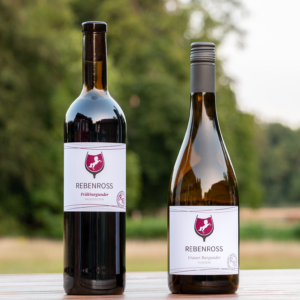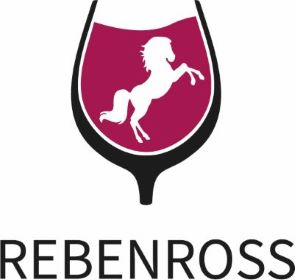Our Wines
Wine is much more than just a drink – it is a cultural tradition, an art form and a source of pleasure. We will take you on a journey through the world of wine, from traditional grape varieties to types of vinification and wine-growing regions. Immerse yourself in the history, flavours and secrets behind every glass of wine and be inspired to discover new things and indulge your senses. Welcome to the world of wine – we look forward to exploring it with you!
You can find detailed information about our wines in our online shop.
White wine grape varieties
White wine epitomises elegance, diversity and sophistication. From refreshing, sparkling varieties to complex, aromatic drops, white wine offers a wide range of flavour profiles and styles to appeal to every palate. With a rich history dating back centuries and a global presence in almost every wine-growing region in the world, white wine has carved out an unrivalled place in the wine world.
German white wine in particular stands out from wines from other countries due to its effervescence, fruitiness and minerality. These special characteristics are due to the climate and soil conditions in German wine-growing regions.
Riesling
Riesling is one of the most prestigious white grape varieties, recognised worldwide for its quality and cultural significance. With a cultivation area of over 24,000 hectares in Germany, which accounts for around 23% of the country’s total vineyard area, Riesling is a dominant force in German viticulture. The variety is mainly grown in cooler climatic regions, which gives it a fresh, lively acidity and a unique flavour. The world’s first documented mention of Riesling dates back to 1435 in an invoice from the town of Rüsselsheim. Nowadays, Riesling is known internationally as “Rheinriesling” and has established itself as one of the leading grape varieties. Its characteristic flavour profile includes fruity notes of stone fruit and exotic fruits, paired with a zesty acidity. This versatility makes Riesling a popular choice for winemakers and wine connoisseurs alike.
Pinot Gris
Pinot Gris, also known as Ruländer, is a renowned white wine grape variety that is prized for its diverse flavours and full-bodied character. Originally native to Burgundy or Champagne, the variety was introduced to Germany in the 14th century and has been successfully cultivated ever since.
Pinot Gris wines are known for their golden yellow colour and fresh apple notes. They are often full-bodied and rich in extract, and tend to have a higher alcohol content. In Germany, two styles have established themselves for vinification: the traditional, heavy Ruländer and the more modern, elegant Pinot Gris. The latter is characterised by a balanced acidity and less sweetness, which makes it an ideal accompaniment for a variety of dishes.
Germany is second only to Italy in the cultivation of Pinot Gris, which emphasises the importance of this variety for the German wine landscape. With its versatility and appealing flavour profile, Pinot Gris is a popular choice for wine connoisseurs and gourmets worldwide.
Chardonnay
Chardonnay is a globally widespread white wine grape variety of outstanding quality and renown. Originally from the Near East, Chardonnay found its way to France, where it was mainly cultivated in Burgundy. Today it is one of the most popular grape varieties in the world, with around 200,000 hectares under cultivation worldwide.
The variety is characterised by its adaptability to different site conditions and produces appealing wine qualities on a wide variety of soils. Chardonnay wines are known for their full body and high alcohol content. They can have a variety of flavours ranging from tropical fruit to vanilla and floral notes. The best qualities are often produced in special locations with chalky soils.
Chardonnay is produced in various styles around the world, but mostly dry. The grape variety is also becoming increasingly important in Germany, while it already has a long history of success in other wine-growing countries. With its versatility and appealing flavour profile, Chardonnay remains a popular choice for wine connoisseurs and gourmets worldwide.
Würzer
Georg Scheu created the Würzer variety in 1932 at the State Institute for Vine Breeding in Alzey by crossing Gewürztraminer with Müller-Thurgau. Since its official recognition in 1978, Würzer has established itself as the favourite of many wine lovers despite a dwindling vineyard area in Germany.
Despite its limited distribution, Würzer delights with its lively freshness, refined elegance and a distinctive muscat bouquet that emphasises its spicy note. However, in addition to its advantages, Würzer is also susceptible to frost and chlorosis, which makes growing this variety a challenge.
As a variety of the noble grapevine (Vitis vinifera), Würzer has hermaphrodite flowers and is self-fertile, which offers economic advantages in viticulture. Together with the Septimer variety, which originated from the same breeding series and the same parent pair, Würzer contributes to the diversity and quality of wine varieties.
Sauvignon Blanc
Sauvignon Blanc is considered the second most important white quality variety after Chardonnay. With a global cultivation area of 111,000 hectares in 2010, Sauvignon Blanc has seen an increase of 70% since 2000.
Originally native to the Loire Valley in France, names such as Sancerre and Pouilly-Fumé have made the grape variety famous worldwide. Sauvignon Blanc is a natural cross between Traminer and Chenin Blanc and is characterised by fresh aromas of currants and gooseberries, often accompanied by “green” notes such as fresh grass and a mineral undertone.
The worldwide spread of Sauvignon Blanc has led to the wines being vinified in different ways. From France, this grape variety has made a triumphal march around the world in recent decades and is now also widespread in Argentina, Chile, Italy, New Zealand, California and South Africa.
As one of the most widely cultivated white grape varieties, Sauvignon Blanc has been documented in France since 280 AD and remains a favourite wine for wine lovers all over the world due to its versatility and characteristic flavour profile.

Red wine grape varieties
Pinot Noir
Pinot Noir, also known as Pinot Nero, Blauburgunder or Schwarzburgunder, is an important red wine variety of high quality that has found worldwide distribution and recognition. Often referred to as the “king of red wines”, Pinot Noir is mainly cultivated in cooler wine-growing regions such as Burgundy, the Ahr and the Palatinate.
The origins of Pinot Noir date back to around 2000 years ago, with the area between Lake Geneva and the Rhône Valley considered the possible home of this grape variety. The name “Pinot” could derive from the long, conical grape shape, while “Burgundy” goes back to an import of vines from Burgundy to the Ahr in the 18th century.
Today, Pinot Noir is mostly vinified as a single variety and is known for its ability to convey the specific terroir. However, the grape variety is demanding, both in the vineyard and in the cellar, and requires careful handling in order to preserve its characteristic qualities.
In Germany, the cultivation of Pinot Noir occupies a significant place, with around 11.4% of the vineyard area planted with this variety. The wines are mainly vinified as dry red wines and have gained a firm place in the world of wine due to their quality and unique flavour profile.
Pinot Madeleine
Pinot Madeleine is a remarkable red wine variety that has emerged from a natural mutation of Pinot Noir. It owes its name “Frühburgunder” to its ability to ripen around two weeks earlier than Pinot Noir, which makes it less susceptible to grey mould rot and leads to a special variety of flavours.
The berries of Pinot Madeleine are smaller than those of its famous brother, which means that the flavours are more concentrated in the skin. This often results in more velvety and full-bodied wines. Due to its early maturity, Pinot Madeleine was also often used as a crossing partner for new grape varieties, resulting in interesting wine creations.
Although Pinot Madeleine was threatened with extinction in Germany in the 1960s, its potential was later recognised. Its susceptibility to disease was tackled through systematic clonal selection and development, which contributed to its preservation and further development.
Other types of wine
Blanc de Noir
Blanc de Noirs, literally translated as “white from black”, refers to a white wine, champagne or crémant made from red wine varieties. Although the term is not defined in German wine law, it is not criticised.
The juice of most grapes is pale, regardless of the colour of the skin, as the colouring agents are almost entirely contained in the skin. To obtain a light-coloured wine, the juice is separated from the skins before fermentation. This process is also used to produce a white wine from Pinot Noir and Pinot Meunier in France, which gives Champagne weight and body. In contrast to the almost colourless Blanc de Blancs, the Blanc de Noir has a light rosé hue.
Secco
According to German wine law, sparkling wine is defined as wine that has a higher carbon dioxide content than still wine. While most of the carbon dioxide escapes during the fermentation of grape must into wine, it is captured during the production of high-quality Seccos and returned to the wine after fermentation.
Seccos have a carbon dioxide pressure of only 1 to 2.5 bar, compared to sparkling wine, which has a carbon dioxide pressure of at least 3 and up to 6 bar. The closures of Seccos must not be fixed with a wire basket (agraffe) as with sparkling wine, but are usually closed with a screw cap or a cork with shrink film on top.
Non-alcoholic Secco
Non-alcoholic Secco is a refreshing alternative for anyone who wants to enjoy the flavour of Secco but without the alcohol. Unlike traditional Secco, which is produced by fermenting grape must, alcohol-free Secco is made from grape juice to which carbon dioxide is added to give it a light perlage.
This alcohol-free Secco offers the sparkling pleasure of a traditional Secco, without the alcohol.
Rheinhessen wine region
Rheinhessen, Germany’s largest wine-growing region, stretches across rolling hills and vast vineyards between Mainz, Worms and Bingen. With a vineyard area of 26,860 hectares, characterised by 414 individual vineyards, this region offers ideal conditions for viticulture. People have been growing wine here since Roman times and the region can look back on a long wine-growing tradition. The warm, dry climate at 50 degrees latitude favours the cultivation of white grape varieties, which make up around 70% of the area, including Riesling, white Burgundy varieties, Müller-Thurgau and Silvaner. But Rheinhessen also has a lot to offer in terms of red grape varieties, especially Dornfelder and Pinot Noir. The young generation of winegrowers has caused a stir in recent years with their outstanding wines, and the region is increasingly focussing on quality and diversity. The wines from Rheinhessen are labelled with the “protected designation of origin” and are an expression of a wine culture on the Rhine that is thousands of years old.

All of our Rebenross wines currently come from the picturesque Rheinhessen region. Why Rheinhessen in particular? It’s simple: we have a special fondness for the wines of this region, because they never fail to impress us with their outstanding quality and unmistakable flavour. We also maintain close friendships with the local winegrowers, who produce their wines with great passion and expertise. Nevertheless, we are always on the lookout for new partnerships and would like to expand our range to include wines from other German wine-growing regions. We are looking forward to getting to know new winegrowers and their unique creations so that we can offer you an even more varied selection. Until then, we invite you to discover the delicious wines from Rheinhessen and join us on an enjoyable journey through this fascinating wine region.
